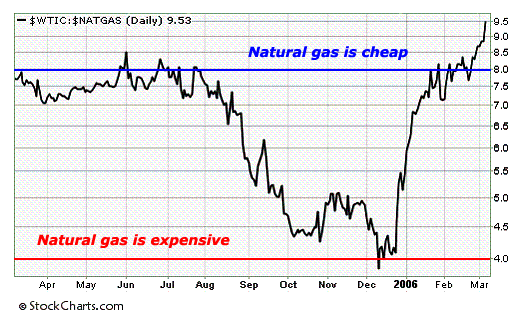| Home | About Us | Resources | Archive | Free Reports | Market Window |
A Double Bargain in the Energy MarketBy
Thursday, June 8, 2006
When you’re after great values in oil and natural gas stocks, you occasionally run into a problem... How do you compare the value of a company whose resources are mostly natural gas with one whose resources are mostly oil? Analysts do it all the time. They have a simple ratio to help them. That ratio states: 6,000 cubic feet of gas is equal to 1 barrel of oil. So... if your favorite oil company lists their reserves as 60,000,000 cubic feet of natural gas, you can calculate that volume in barrels of oil by dividing it by 6000. Therefore, you’d know that this company’s reserves were equivalent to 10,000 barrels of oil. Here’s how our ratio works with today’s prices: A barrel of crude oil is trading for around $61. Its “equivalent” in natural gas is trading for around $6.65. Now let’s run the numbers: $61 oil divided by $6.65 natural gas = 9.2 At a ratio of 6, analysts consider natural gas and oil to be roughly of equal value. When the ratio is above 6, natural gas is cheap compared to oil. When the ratio is below 6, natural gas is expensive compared to oil. The chart below shows how natural gas was expensive through most of the fall when compared to oil. In December, natural gas was very expensive. At the peak, it sold at a 54% premium to oil, the equivalent of $92 per barrel!
“Expensive” natural gas didn’t last long... we’re reaching the end of the warmest winter in a century. Since such a large amount of natural gas is used to heat homes and factories, warm temperatures mean less gas demand. Prices have crashed. Now, at a ratio around 9, you can see that oil holds the premium over gas. Said another way, natural gas is CHEAP in relation to oil right now, selling at a 37% discount.
When natural gas is above 6 on this scale, its utility is very high. That means if your electrical generation plant can run off oil or natural gas, you choose the cheapest source of fuel. Right now, you would choose natural gas. I’d even favor natural gas over crude when the ratio is at 6, as natural gas is a cleaner source of energy. Right now, natural gas is selling at an equivalent of $39 per barrel while oil is up around $60. That’s really cheap natural gas. Don’t think that things will remain this way. Fundamentals will reassert themselves sooner or later and the ratio will return to a more normal level. In the meantime, investors can take advantage of depressed natural gas prices and buy stock in an energy producer with a lot of exposure to gas. In my newsletter, S&A Oil Report, I’ve recommended Anadarko Petroleum (APC) as just such an opportunity. Not only is Anadarko set to benefit from rising natural gas prices, it’s also an attractive takeover bargain for an energy supermajor looking to pay up and replace reserves. Dirt-cheap natural gas and a possible buyout? I call that a double bargain. Best Regards, Matt Badiali Market NotesWHAT’S HAPPENING WITH THE WORLD’S RISKIEST STOCKS? It’s getting ugly for Russian stocks. To get an idea of what’s happening to this market, let’s look at the Templeton Russia Fund (TRF)… Due to the huge money flow into risky emerging markets like Russia, this popular ETF soared for most of 2006. But as today’s chart shows, that money flow works both ways. The herd is getting spooked out of risky assets… their money is flowing out… and the Templeton Russia Fund is getting obliterated. Money flows out of TRF… down 25% in the past month: |
Recent Articles
|


